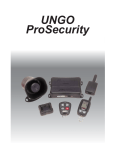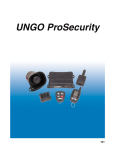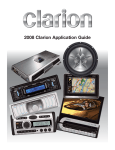Download Clarion UNGO MS8200 Installation guide
Transcript
UNGO ProSecurity Ungo – Information K20 RK20 KEYLESS ENTRY SYSTEM REMOTE ENGINE START WITH KEYLESS ENTRY Features Features • (2) 4-Button Remote Transmitters (SAA474U) • 2 Auxiliary Outputs • On-Board Relays for Door Locks and Dome Light Supervision • Horn Honk Output • Driver’s Door Unlock Priority Compatible • Comfort Closure • (+/-) Parking Light Output • Common Features • • • • • • • • • • S100 S670 SECURITY SYSTEM TWO-WAY SECURITY SYSTEM Features Features • • • • • • • • • • • • • • • (2) 4-Button Remote Transmitters (SAA474U) 2 Auxiliary Outputs (+/-) Parking Light Output ProSecurity Programmer Compatible Common Features Common Security Features (2) 4-Button Remote Transmitter (SAA474U) Intelli-Tach RPM Detection On-Board Remote Start Relays D2D Serial Port for D2D Compatible Xpresskit Modules 1 Auxiliary Output (-) Door Lock Outputs Short Run / Turbo Timer Mode (+/-) Parking Light Output Comfort Closure ProSecurity Programmer Compatible (1) 2-Way LCD Remote Transmitter (SAA477U) (1) 4-Button Remote Transmitter (SAA474U) 3 Auxiliary Outputs On-Board Relays for Door Locks and Dome Light Supervision Horn Honk Output (+/-) Parking Light Output Comfort Closure Common Features Common Security Features 169 Ungo – Information SR7000 SR9000 TWO-WAY SECURITY SYSTEM WITH REMOTE ENGINE START 1-MILE RANGE TWO-WAY SECURITY SYSTEM WITH REMOTE ENGINE START Features Features • • • • • • • • • • • • • • • • • • • • • • • • • • • (1) 2-Way LCD Remote Transmitter (SAA477U) (1) 4-Button Remote Transmitter (SAA474U) Intelli-Tach RPM Detection D2D Serial Port for D2D Compatible Xpresskit Modules 3 Auxiliary Outputs Short Run / Turbo Timer Mode Compact Satellite Relay Pack Driver’s Door Unlock Priority Compatible (+/-) Parking Light Output Dedicated Horn Honk Output ProSecurity Programmer Compatible Common Features Common Remote Start and Security Features 170 2-Way LCD Remote Transmitter (SAA7701U) SDC (Secure Digital Communication) capable of 1-Mile Range 4 Auxiliary Outputs Short Run / Turbo Timer Mode Compact Satellite Relay Pack Driver’s Door Unlock Priority Compatible Built-In Wait to Start Diesel Timer Driver's Door Priority Defroster Output Comfort Closure Dedicated Horn Honk Output ProSecurity Programmer Compatible Common Features Common Remote Start and Security Features UNGO – Features and Technologies Common UNGO Features Anti-Code Grabbing Technology Individual Remote Recognition Keyless Entry* Remote Enabled Valet Hyper Blue Status LED Remote Panic Selectable Ignition Controlled Door Locks ProSecurity Starter Disable* ProSecurity Power Up Progressive Door Unlock* Dome Light Supervision Output* Trunk/Hatch Release Output* * May Require Additional Parts & Labor Common Security Features Extended Range Antenna Dual Stage Impact Sensor Programmable Override Sequence Remote Silent Arm/Disarm Capability Event History Diagnostics Selectable Siren Duration and Tones False Alarm Prevention Circuitry Common Remote Start Features Extended Range Antenna Anti-Grind Circuitry Tachometer or Voltage Sensing Gasoline or Diesel Vehicle Compatible Over and Under Rev Protection Built-in Wait-to-Start Timer Selectable Run Timer Short Run Timer / Turbo Timer Mode Rear Defroster Activation UNGO Feature Descriptions Secure Digital Communications In order to achieve a reliable 1-Mile of range from the SR9000, Clarion has implemented Spread Spectrum Technology Secure Digital Communication. Spread Spectrum Technology takes a signal (in the case of the SR9000, a rolling code that tells the system what do to) and spreads the code over a wide range of frequencies. The advantage of this is that because the signal is so spread out, it becomes more resistant to interference, and helps to guarantee the signal is received and decoded. Ungo Spread Spectrum Technology operates at 900Mhz, further improving its resistance to interference Anti-Carjacking The optional anti-carjacking system feature is designed to ensure that any unauthorized user of the vehicle (even using the keys and remote control) will not be able to permanently separate the owner from their vehicle. This system cannot prevent a carjacking attempt; however, it does ensure that if an unauthorized user takes the vehicle, it will be disabled (after several progressive warnings) as a safely as possible. Anti-Code Grabbing Technology (a.k.a. Code Hopping): The receiver and remotes use a mathematical formula called an algorithm to change their code each time the remote is used. This technology has been developed to increase the security of the unit. The control unit knows what the next codes should be. This helps to keep the remote “in sync” with the control unit even if you use the remote control out of range of the vehicle. 171 UNGO – Features and Technologies Anti-Grind Circuitry Whenever the vehicle is remote started, advanced anti-grind circuitry prevents the starter from engaging, even if the key is turned to the start position. This prevents damage to the starter motor if the key is turned to the start position during remote start operation. Built-in Wait-to-Start Timer Diesel vehicles need adequate time to warm up the glow plugs prior to starting. When the remote start is activated, the wait-to-start timer will allow the glow plugs to properly warm up before engaging the starter circuit. This feature prevents damage to the motor and glow plugs during remote start operation. Comfort Closure If programmed ON the door lock output will activate the Comfort Closure output for 20 seconds. This output will begin 200mS after the final door lock output has completed regardless of the door lock programming. This feature is designed to integrate with vehicle that can close the power windows and sunroof by holding the key in the driver door lock position, and will operate on both single input systems and two pulse dead bolt systems. Dome Light Supervision Output The dome light will illuminate for 30 seconds each time the system is disarmed using the remote control. This is useful for seeing inside the vehicle at night prior to entering it. Dual Stage Impact Sensor A sensor mounted in the vehicle that is designed to pick up impacts to the vehicle or glass. Depending on the strength of the impact, the sensor can determine whether it’s an accidental contact or actual violation attempt. Event History Diagnostic ProSecurity systems can provide notification that the alarm was previously triggered. The status 172 LED will indicate which zone was involved. The system will retain this information in its memory, until the next time the ignition key is turned ON. Extended Range Antenna An optional external receiver/antenna used to upgrade the remote/receiver performance in areas of high radio interference such as military bases, airports, and hospitals. False Alarm Prevention It prevents annoying repetitive sequences due to faulty door pins switches or environmental conditions such as thunder, jackhammers, airport noise, etc. Gasoline or Diesel Vehicle Compatible ProSecurity remote start systems can be installed into either gasoline or diesel vehicles. Hyper Blue LED A blue LED (Light Emmiting Diode) mounted at a discretionary location inside the vehicle. It is used to indicate the status of your system. Individual Remote Recognition Individual Remote Recognition makes it possible to program different settings for each remote that is used with the system. Then, whenever a specific remote is used, the system will recall the setting assigned to that remote. IDR lets up to four users of the system have different settings that meet their specific needs. It is almost like having four separate alarms in your vehicle, one for each user. Keyless Entry Allows for easy entry or exiting of the vehicle without having fumbling around for keys. May require additional parts and labor. UNGO – Features and Technologies Over and Under Rev Protection Remote Enabled Valet (REV) The system monitors the engine speed and will automatically shut the engine off if the RPMs rise above or fall below the programmed levels. This feature prevents damage to the motor due to fuel delivery system failures or other problems, which may cause the engine to race. The security system will not arm, even with the remote, but all convenience functions (door locks, trunk release, etc.) will still continue to work normally. REV allows access to Valet Mode without having to disclose the location of the Valet/Override switch. Programmable Override Sequence Remote Panic ProSecurity systems can be programmed to respond to one to five pulses of the Valet/ Override Switch for the disarm function. If you are threatened in or near your vehicle, you can attract attention by triggering the system with your remote control. Just press the “PANIC” or “LOCK” button for two seconds, and you will enter Panic Mode. The siren will sound and the parking lights will flash for the programmed siren duration. To stop Panic Mode at any time, press the “LOCK” button on the remote. Progressive Door Unlock For added security, the ProSecurity system can be configured to unlock the driver’s door only, leaving the passenger doors locked. Pressing the UNLOCK button an additional time will unlock the passenger doors. This option requires additional parts and labor. ProSecurity Power Up The ProSecurity system will store its current state of non-volatile memory. If the power is lost and then reconnected the system will recall the stored state from memory. This means if the unit is in Valet Mode and the battery is disconnected for any reason, when the battery is reconnected the unit will still be in Valet Mode. ProSecurity Starter Disable An automatic switch controlled by your system that prevents the vehicle’s starter from cranking whenever the system is armed. The vehicle is never prevented from cranking when the system is disarmed, in Valet Mode, or if the starter interrupt switch itself fails. Rear Defroster Activation During remote start operation, the rear defroster can be activated. This option requires additional parts and labor. Remote Silent Arm/Disarm Capability The siren chirps upon arm or disarm can be temporarily eliminated for that one operation only. The siren arm/disarm chirps can be turned off permanently, if desired. The siren chirps will also be eliminated during the warn-away trigger of the Dual Stage Impact Sensor. Selectable Ignition Controlled Door Locks When the ignition is turned ON, the doors will lock within 3 seconds and unlock when the ignition is turned OFF. Ignition controlled lock and unlock are independent features are can be programmed separately. Selectable Siren Duration and Tones The duration of the siren can be programmed to either 30 or 60 seconds. Some states have laws regulating how long a security system can sound. The multi-tone sirens included with ProSecurity systems can be easily modified to select desired tones or single tone. 173 UNGO – Features and Technologies Short Run Timer / Turbo Timer Mode D2D Short run turbo mode keeps the engine running after arriving at your destination for a programmable period of time. The system has the ability to interface with an XK module through the D2D port. The advantage of using a D2D interface is that there is less wiring involved in the installation. Check the XK module installation guide to determine which wires are not needed, and which options are available. Intelli-Tach RPM Detection Intelli-Tach is a new feature for Ungo in 2009. It is the default RPM-sensing method for the RK20 and SR7000 systems. Intelli-Tach gives the installer the performance of a hard wired tach wire, with the convenience of voltage sensing. It is far superior to any voltage-sense feature you've tried before Intelli-Tach monitors the cranking voltage of the vehicle using a very fast micro controller and an analog-to-digital converter. The microprocessor "saves" the base voltage as a reference. When Intelli-Tach "sees" the slightest uptick in voltage, indicating that the alternator is charging the battery, the starter motor shuts off instantly. Tachometer or Voltage Sensing ProSecurity remote start systems either use a tachometer signal or sense the voltage of the vehicle during remote start activation. These signals inform the remote start system that the vehicle has successfully started and is running. Trunk/Hatch Release Output The system’s auxiliary output can be programmed to operate a factory power release for the vehicle’s trunk or hatch. If the factory release is not power activated, an optional trunk release solenoid can often be added. This output will then disable / ignore the two-stage shock sensor as you load and unload the vehicle. 174 UNGO – Application Notes Obtaining Optimal Range It is recommended that all security components be grounded at the same location. Mounting the Extended Range Antenna: Turning Off the Anti-Code Grabbing Technology (a.k.a. Code Hopping): 1. Clean the mounting area with a quality glass cleaner or alcohol to remove any dirt or residue. 2. Plug the receiver/antenna cable into the receiver/antenna. 3. Mount the receiver/antenna vertically using the supplied double-sided tape. 4. Route the receiver/antenna cable to the control module and plug it into the four-pin antenna connector. Important: • To achieve the best possible range, DO NOT leave the antenna cable bundled up tightly underneath the dash. Try to extend the cable the full length during installation. • DO NOT mount the control module to close the vehicle’s Body Control Module and/or Electronic Control Modules. Mounting the Standard Antenna: 1. Route the antenna as high up as possible, extending it to its full length. 2. Secure it in place using a cable tie. Important: • DO NOT cut or extend the antenna, as it’s tuned precisely to the control unit. • Route the antenna away from moving parts under the dash and from the vehicle’s Body Control Module and/or Electronic Control Modules. Mounting the Control Unit: • Do not mount or secure the control unit to close to the vehicle’s Body Control Module and/or Electronic Control Modules. • Do not mount or secure the control unit to close sources of heat, such as the heater core and/or air ducts. • Ground the control unit to a clean, paint-free sheet metal location using a factory bolt that DOES NOT have any vehicle component grounds attached to it. A screw should only be used when in conjunction with a two-sided lock washer. Under dash brackets and door sheet metal are not acceptable ground points. Although this is a feature designed to prevent the remote transmitters from being cloned and retransmitted to the control unit, it is virtual impossible to do. “Code Grabbers” have a very limited range, usually required to within 5 feet of the remote transmitter while the button is being depressed. By turning the off the Anti-Code Grabbing feature, it can increase the receiving/ transmitting range by 30-35%. Refer to the “System Features Menu” for the Feature Number and programming instructions. Double Stacking (2) CR2016 Batteries: The CR2032 3-volt micro lithium coin cell battery inside of the SAA474U (4-button) remote transmitter can be substituted with (2) CR2016 3-volt batteries. This can increase the range between 65-75%, depending on the surroundings. Procedure: 1. Insert a small flat head screwdriver into the notch on the bottom of the remote transmitter. 2. Gently twist the screwdriver to spreading apart the two halves of the remote transmitter. 3. Open up the remote transmitter exposing the CR2032 battery and slide it out. 4. Slide (2) CR2016 batteries into the battery holder with the “+” facing upwards. (It may be easier to slide one battery in at a time. With the first battery in place, slide the second battery between the PC board and battery.) 5. Prior to closing the two halves of the remote transmitter, verify the batteries are installed correctly by pressing any of the buttons. The green LED indicator should illuminate when a button is pressed. If the LED does not illuminate, double-check the direction of the batteries. The “+” should be facing upwards matching the “+” on the battery retaining clip. 6. Snap together the two halves of the remote transmitter. 175 UNGO – Application Notes Obtaining a Tachometer Reference Signal The tachometer reference signal is an essential signal for the safe operation of a remote start system. This signal informs the remote start module that the vehicle has successfully started and is running. It can also determine whether the vehicle is idling at a safe RPM level. In the event the vehicles idle is racing or below safer operating level, the remote start module will shut down. To test for a tachometer wire, a multi-meter capable of test AC voltage must be used. The tachometer wire will show between 1V and 6V AC. In multi-coil systems, the system can learn individual coil wires. Individual coil wires in a multi-coil ignition system will register lower amounts of AC voltage. Also, if necessary, the system can use a fuel injector control wire for engine speed sensing. Common locations for a tachometer wire are at the ignition coil, back of the gauge cluster, engine computers, and automatic transmission computers. How to Find a Tachometer Wire with a MultiMeter: remote start module. It is highly recommended to solder this connection, due to the heat generated inside the engine bay. Using t-taps or scotch-locks are likely to fail due to the heat. Fuel Injector Wire: 1. Examine the individual fuel injectors and determine which wire(s) are common on each fuel injector. 2. The “different” colored wire can be used for the tachometer reference signal for the remote start module. (Only one fuel injector wire is necessary.) 3. Teach tachometer reference signal to the remote start module. It is highly recommended to solder this connection, due to the heat generated inside the engine bay. Using t-taps or scotch-locks are likely to fail due to the heat. Tachometer Reference Options Tachless 1. Set the multi-meter to ACV or AC voltage (12V or 20V is fine) 2. Attach the (-) probe of the meter to chassis ground. 3. Start the vehicle and allow it to reach its normal idle speed. 4. Probe the wire you suspect of being the tachometer wire with the red probe of the meter. 5. If it’s the correct wire the meter will read between 1V and 6V. If programmed to the voltage sense setting, the unit will crank the starter for a preset time during. Once the starter has been engaged, the system will check the voltage level to verify the engine is running. Multi-Coil Systems: Some vehicles have many accessories, which are turned on during remote start activation. In these vehicles, the variation of voltage between the engine off and the vehicle running is very slight and the remote start module may “think” the vehicle has not started. This can cause the remote start module to shut down after the vehicle has been started. If this is the case, the Voltage Check Level must be set to the LOW position. 1. Examine the individual coils and determine which wires are common on each coil. (Example: 2002 Chevy Pick-up: Each coil has 4 wires, three common wires on each coil and the 4th wire changes.) 2. The “different” colored wire can be used for the tachometer reference signal for the remote start module. (Only one coil wire is necessary.) 3. Teach tachometer reference signal to the 176 When using tachless operation, it is essential to determine the correct crank time to prevent damage to the starter. It may take several remote start activations to determine the crank time. UNGO – Application Notes / Terms Voltage sensing is not recommended in areas that experience extreme cold temperatures. The resistance in the vehicles wiring increases which can cause intermittent remote start reliability. 454T: Alternator RPM Monitor The 454T Alternator RPM Monitor is for use with remote engine starts as an alternative to direct connection to the vehicle’s tachometer or fuel injector wire. It detects electrical spikes in the vehicles electrical system and converts them into an output that simulates a tachometer. Passlock 2 The Passlock 2 system must see the correct resistance code at the correct time. When the ignition switch is turned to the crank position, the “Bulb Check” wire is switched to ground. This starts a time window during which the instrument cluster panel (IPC) analyzes the resistance code (R-Code). If the R-Code is valid and is received in the proper window of time, the IPC sends a code via data bus to the PCM to enable the fuel injection system. If the key cylinder itself is pulled out or damaged, it will not generate the resistance code and the vehicle will not run. Passkey 3 Remote Start Terms and Definitions Immobilizer (a.k.a.: Transponder) The Immobilizer uses an antenna ring around the ignition cylinder to energize a small transponder chip hidden in the ignition key. When the ignition is turned on, the chip is energized and the antenna rings sends the code to the Immobilizer control unit. The vehicle will only start if the code matches the one programmed into the vehicle. Passkey/VATS The Passkey/VATS system consists of four parts: the Passkey cylinder, the ignition switch, the instrument cluster panel (IPC), and the power train control module (PCM). The system requires that the key cylinder be mechanically turned using a key. When the key cylinder is properly turned, it generates a resistance code (R-Code), which is sent to the IPC. The vehicle will only start if the R-Codes match the key and key cylinder. The Immobilizer uses an antenna ring around the ignition cylinder to energize a small transponder chip hidden in the ignition key. When the ignition is turned on, the chip is energized and the antenna rings sends the code to the Immobilizer control unit. If the code is incorrect the vehicle will not start. PATS Passive Anti-Theft System (PATS) uses a specially programmed key to start the vehicle, similar to the Immobilizer. It uses an antenna ring around the ignition cylinder to energize a small transponder chip hidden in the ignition key. When the ignition is turned on, the chip is energized and the antenna ring sends the code to the PATS control unit. If the code is incorrect the vehicle will not start. Resistor One of the components necessary in interface with VATS factory anti-theft systems. A resistor(s) are used in conjunction to reproduce the resistance code (R-Code) embedded in the vehicle’s key 177 Replacement Remote Controls Model Number Remote Description 5000-1 1 BUTTON TRANSMITTER FOR 5000 SERIES SAA3651 5000-2 2 BUTTON TRANSMITTER FOR 5000-2 SERIES SAA3652 6200 2 BUTTON TRANSMITTER (RED LED) SAA3623 6200V 2 BUTTON VARICODE TRANSMITTER SAA3624 6400 2 BUTTON TRANSMITTER (RED LED) SAA3623 6400V 2 BUTTON VARICODE TRANSMITTER SAA3624 6500 4 BUTTON TRANSMITTER (RED LED) SAA3649 6500V 4 BUTTON VARICODE TRANSMITTER SAA3650 CS100 2 BUTTON VARICODE TRANSMITTER SAA3624 CS105 2 BUTTON REMOTE TRANSMITTER FOR CS105 SAA200T CS150 3 BUTTON REMOTE TRANSMITTER SAA150T CS200 2 BUTTON REMOTE TRANSMITTER FOR CS200 SAA200T G1100 3 BUTTON REMOTE TRANSMITTER SAA003T G1100 4 BUTTON REMOTE TRANSMITTER SAA004T GUARDSMAN 2 BUTTON GUARDSMAN TRANSMITTER SAA3601 GUARDSMAN VARICODE TRANSMITTER - 1000V SERIES SAA3100 K10 4 BUTTON REMOTE TRANSMITTER SAA474U KE106 3 BUTTON REMOTE TRANSMITTER SAA003T KE106 4 BUTTON REMOTE TRANSMITTER SAA004T MC500 2 BUTTON VARICODE TRANSMITTER SMA3255 MS1000 2 BUTTON VARICODE TRANSMITTER SAA3624 MS1001 2 BUTTON VARICODE 2 TRANSMITTER SAA3704 MS2000 3 BUTTON REMOTE TRANSMITTER SAA003T MS2000 4 BUTTON REMOTE TRANSMITTER SAA004T MC2000V 2 BUTTON VARICODE TRANSMITTER SMA3255 MS2002 3 BUTTON REMOTE TRANSMITTER W/PURPLE BUTTONS SAA3715 MS2004 4 BUTTON REMOTE TRANSMITTER SAA004T MS2005 4 BUTTON REMOTE TRANSMITTER SAA004T MS2006 5 BUTTON REMOTE TRANSMITTER SAA005T MS2007 5 BUTTON FM 2-WAY LCD TRANSMITTER MS2100 5 BUTTON REMOTE TRANSMITTER SAA205T MS2105 5 BUTTON REMOTE TRANSMITTER SAA205T MS2106 5 BUTTON REMOTE TRANSMITTER SAA205T MS2107 5 BUTTON REMOTE TRANSMITTER SAA205T MS2107 5 BUTTON FM 2-WAY LCD TRANSMITTER SAA217T MS3001 3 BUTTON VARICODE 2 TRANSMITTER SAA3705 178 Remote Part Number SAA217T Generic Replacement Remote Controls MS3200 3 BUTTON VARICODE 2 TRANSMITTER SAA3705 MS3200 3 BUTTON VARICODE 2 TRANSMITTER SAA3706 MS3200 3 BUTTON REMOTE TRANSMITTER W/PURPLE BUTTONS SAA3715 MS5000 3 BUTTON VARICODE 2 TRANSMITTER SAA3703 MS5500 3 BUTTON REMOTE TRANSMITTER W/ BLUE BUTTONS SAA3716 MS5505 3 BUTTON VARICODE 2 TRANSMITTER SAA3716 MS7000 3 BUTTON VARICODE 2 TRANSMITTER SAA3703 MS8200 3 BUTTON VARICODE 2 TRANSMITTER SAA3706 MS8200 3 BUTTON REMOTE TRANSMITTER W/ BLUE BUTTONS SAA3716 MS8300 3 BUTTON VARICODE 2 TRANSMITTER SAA3706 MS8300 3 BUTTON REMOTE TRANSMITTER W/ BLUE BUTTONS SAA3716 MS850 2 BUTTON REMOTE TRANSMITTER W/PURPLE BUTTONS SAA3714 MS9000 3 BUTTON VARICODE 2 TRANSMITTER SAA3703 RK1/RK20 4 BUTTON REMOTE TRANSMITTER SAA474U RS151 4 BUTTON REMOTE TRANSMITTER SAA004T RS251 4 BUTTON REMOTE TRANSMITTER SAA251T RS300 5 BUTTON REMOTE TRANSMITTER SAA205T S100 4 BUTTON REMOTE TRANSMITTER SAA474U S400 4 BUTTON REMOTE TRANSMITTER SAA474U S660 2-WAY REMOTE TRANSMITTER SAA477U S670 2-WAY REMOTE TRANSMITTER SAA477U RS10 4 BUTTON REMOTE TRANSMITTER (Number Pads SAA874) SAA474U K10 4 BUTTON REMOTE TRANSMITTER SAA474U K20 4 BUTTON REMOTE TRANSMITTER SAA474U SAS6200 2 BUTTON VARICODE TRANSMITTER SAA3624 SAS6400 2 BUTTON VARICODE TRANSMITTER SAA3624 SAS6500 4 BUTTON VARICODE TRANSMITTER SAA3650 SMS0500 2 BUTTON VARICODE TRANSMITTER SAA3624 SMS2000 2 BUTTON VARICODE TRANSMITTER SAA3624 SR1000 4 BUTTON REMOTE TRANSMITTER SAA474U SR5000 2-WAY LCD TRANSMITTER SAA477U SR5000 4 BUTTON REMOTE TRANSMITTER SAA474U SR6000/7000 2-WAY LCD TRANSMITTER SAA477U SR6000/7000 4 BUTTON REMOTE TRANSMITTER SAA474U SR9000 2-WAY SST REMOTE TRANSMITTER SAA7701U TECHNE 1 BUTTON TRANSMITTER - JUMPER PROGRAMMING SAA3621 TECHNE 2 BUTTON TRANSMITTER - JUMPER PROGRAMMING SAA3622 179 UNGO – Application Notes 180 UNGO – Application Notes 181 UNGO – Application Notes 182 UNGO – Application Notes ByPass Notes: 183 UNGO – Remote Start Diagnostics Remote Start Diagnostics The starter continues to crank even though the engine has started. In the event that a remote start system fails to start, or stops running after a short period of time, you can retrieve the source of the shutdown from the UNGO ProSecurity system 1. Has the tach wire been learned? See Tach Learning section of the installation guide. 2. Is the tach wire receiving the correct information? Either the wrong tach wire has been used, or a bad connection exists. 1. Turn the Ignition off 2. Press and hold the Override switch 3. Turn the ignition on then off 4. Release the Override switch 5. Press and release the Override switch. The LED will now report the last system shutdown by flashing one of the following patterns for a period of one minute. LED Flashes One Two Three Four Six Seven Eight Shutdown Cause System Timed Out Over-Rev Shutdown Low or no RPM Remote Shutdown or optional button +/- Shutdown (-) Neutral safety shutdown Wait-to-start timed out. Remote Start Troubleshooting The ignition comes on, but the starter will not crank 1. Does it start with the key in the ignition? If so, does the vehicle have a VATS Pass-Key system? 2. Will it start with the brake pedal depressed? (Make sure to disconnect the brake shutdown when performing this test.) If so, it may have a brake/starter interlock. 3. Is the correct starter wire being energized? Check by energizing it yourself with a fused test lead. The starter cranks for six seconds but does not start. 1. Either the wrong ignition wire is being energized, the unit’s ignition and accessory wires have been connected backwards, or the vehicle has two ignition circuits. Try activating the unit with the ignition key in the “run” position. If the vehicle then runs normally, retest your ignition system. 184 The climate control system does not work while the unit is operating the vehicle. Either the wrong accessory wire is being energized or more than one ignition or accessory wire must be energized in order to operate the climate control system. The remote start will not activate. 1. Check harnesses and connections. Make sure the harnesses are fully plugged into the remote start module. Make sure there are good connections to the vehicle wiring. 2. Check voltage and fuses. Use a meter and check for voltage between the red wire in the 5 pin ribbon harness and the black ground wire. If you have less than battery voltage, check both 30A fuses on the relay satellite. Also make sure that the ground wire is going to a chassis ground and not to something under the dash. 3. Check diagnostics. The diagnostics will tell you which shutdown is active or not connected. The remote start will activate but the starter never engages. 1. Check for voltage on the purple starter wire two seconds after the remote start becomes active. If there is voltage present, skip to Step 4. If there is not voltage present, advance to Step 2. 2. Check the 30A fuses. 3. Check diagnostics. If the gray/black wire is detecting ground upon activation, the starter will not crank. 4. Make sure the purple starter wire is connected to the correct starter wire. 5. Does the vehicle have an immobilizer? Some immobilizer systems will not allow the vehicle to crank if active. 6. Check connections. The two red heavy gauge input wires on the relay satellite should have solid connections. “T-taps”, or “scotch locks” are not UNGO – Remote Start Diagnostics recommended for any high current heavy gauge wiring. Also, if the vehicle has more than one 12-volt input wire, then connect one red wire to each. The vehicle starts, but immediately dies 1. Does the vehicle have an immobilizer? The vehicles immobilizer will cut the fuel and/or spark during unauthorized starting attempts. 2. Is the remote start programmed for voltage sense? If so, the start time may not be set high enough, or you may have to adjust the voltage threshold in programming. Voltage sense will not work on some vehicles. 3. Check diagnostics. Sometimes a shutdown will become active during cranking or just after cranking. The vehicle starts, but the starter keeps running 1. Is the system programmed for engine checking off or voltage sense? When programmed for either of these features, the engine cranks for the preprogrammed crank time regardless of how long it takes to start the vehicle to actually start. Adjust to a lower cranking time. 2. Was the Tach Learn successful? The LED must light solidly and brightly to indicate a successful learn. 3. Make sure that there is a tach signal right at the purple/white tach input wire of the remote start. If not, recheck the connection to the vehicle’s tach wire and make sure the wire is not broken or shorted to ground leading to the remote start. The vehicle will start and run only for about 10 seconds 1. Is the remote start programmed for voltage sense? Try programming the unit for low voltage reference. If this does not work, a tach wire should be used. 2. Check diagnostics. 185 UNGO – Multiple Vehicle Operation Technical Information: Multiple Vehicle Operation Ungo ProSecurity remote transmitters are capable of operating multiple vehicles equipped with ProSecurity systems. This is beneficial for individuals with multiple vehicles and/or reducing the clutter on a keychain. 1. Follow the remote programming procedure for the particular ProSecurity system and delete all the remote transmitters for both vehicles. 2. Follow the remote programming procedure for the particular ProSecurity system and program the desired function to the assigned button. Continue this process until all the button assignments have been complete on both vehicles. EXAMPLE: S100 Multiple Vehicle Operation Programming Vehicle 1. 1. Open the door of the Vehicle 1. 2. Turn the ignition ON 3. Press the Valet/Override button 9 times and then press it one more time and hold it in. The LED will flash 9 times indicating that selection. 4. Release the Valet/Override button and turn the ignition OFF and then back ON. 5. Press the Valet/Override button 4 times and then press it one more time and hold it in. 6. Press the LOCK button on each remote transmitter. The LED will flash 4 times indicating that selection. 7. Release the Valet/Override button and press it 1 time and then hold it in. The LED will flash 5 times indicating that selection. 8. Press the UNLOCK button on each remote transmitter. The LED will flash 5 times indicating that selection. 9. Release the Valet/Override button and turn the ignition OFF and then back ON. 10. Turn the ignition ON. 11. Press the Valet/Override button 2 times and then press it one more time and hold it in. 12. Press both the LOCK and UNLOCK buttons together on each remote transmitter. The LED will flash 2 times indicating that selection. 13. Release the Valet/Override button and turn the ignition OFF. 186 UNGO – Multiple Vehicle Operation Vehicle 1: LOCK: Arm (Lock) UNLOCK: Disarm (Unlock) LOCK & UNLOCK: Channel 2 (Auxiliary 1) Programming Vehicle 2 1. Open the door of the Vehicle 2. 2. Turn the ignition ON 3. Press the Valet/Override button 9 times and then press it one more time and hold it in. The LED will flash 9 times indicating that selection. 4. Release the Valet/Override button and turn the ignition OFF and then back ON. 5. Press the Valet/Override button 4 times and then press it one more time and hold it in. 6. Press the AUX button on each remote transmitter. The LED will flash 4 times indicating that selection. 7. Release the Valet/Override button and press it 1 time and then hold it in. The LED will flash 5 times indicating that selection. 8. Press the “*” button on each remote transmitter. The LED will flash 5 times indicating that selection. 9. Release the Valet/Override button and turn the ignition OFF and then back ON. 10. Turn the ignition ON. 11. Press the Valet/Override button 2 times and then press it one more time and hold it in. 12. Press both the AUX and “*” buttons together on each remote transmitter. The LED will flash 2 times indicating that selection. 13. Release the Valet/Override button and turn the ignition OFF. Vehicle 2: AUX: Arm (Lock) “*”: Disarm (Unlock) AUX and “*”: Channel 2 (Auxiliary 1) 187 UNGO – Door Lock Application Guide Reverse Polarity Door Lock Systems Aftermarket Door Lock Actuators 188 UNGO – Door Lock Application Guide Vacuum Door Lock Systems The lock pulse duration my be programmed to 3.5 seconds One-Wire Door Lock System This door lock system requires a negative pulse to unlock the foors , and cutting the wire to lock the doors. 189 UNGO – Door Lock Application Guide Multiplexed Door Lock Systems Multiplexed door lock systems have more than one function on the same wire and require the use of different resistor values. It is necessary to use external relays any time a resistor is used. Positive Trigger Multiplexed Door Lock System Test Procedure for Multiplexed Door Lock Systems: 1. Locate the Lock/Unlock wire in the vehicle. 2. Cut the wire in half and determine the polarity of the wire. 3. Using a digital multimeter, measure the resistance for Lock and Unlock. (See Diagram) Test Configuration for Positive Door Lock Systems 190 UNGO – Door Lock Application Guide Multiplexed Door Lock Systems Multiplexed door lock systems have more than one function on the same wire and require the use of different resistor values. It is necessary to use external relays any time a resistor is used. Negative Trigger Multiplexed Door Lock System Test Procedure for Multiplexed Door Lock Systems: 1. Locate the Lock/Unlock wire in the vehicle. 2. Cut the wire in half and determine the polarity of the wire. 3. Using a digital multimeter, measure the resistance for Lock and Unlock. (See Diagram) Test Configuration for Positive Door Lock Systems 191 UNGO – Door Lock Application Guide Multiplexed Door Lock Systems with On-Board Relays Reverse Polarity Door Lock Systems with On-Board Relays: 192 UNGO – Door Lock Application Guide Progressive Door Lock Using Positive Door Lock Trigger 193 UNGO – Door Lock Application Guide Progressive Door Lock Using Negative Door Lock Trigger 194 UNGO – Programming Guide Technical Information Module Programming: Models: K10, K20, S670, RS10 System features can also be changed by using the ProSecurity Programmer 195







































